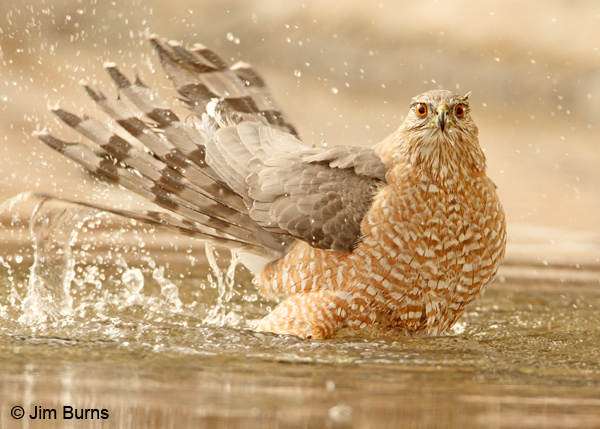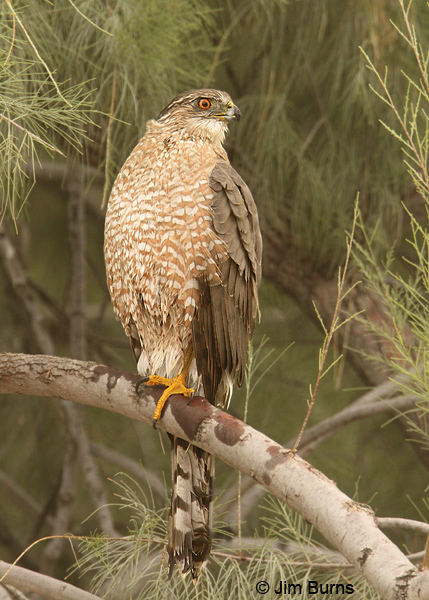
It is 11:23 am, not the ideal time for proper lighting of a lady (the Coop’s large size says “female” to me) bathing, but the sun is bright and illuminates the departing ripples with a rosy glow which perfectly complements the predominant rufous of the hawk’s underparts. All of this, but it is the eyes which carry the scene and steal the soul.
The hawk is looking directly at me, the black pupils large in the shadows of a Tamarisk, the surrounding irises deep and arresting emergency vehicle orange, marking the bird as an adult even more surely than its ventral plumage pattern. Normally the best avian portraits happen with the head in profile. This is not an avian portrait. This is the secret life of birds, an avian reality show. The Coop wants to bathe but, obviously aware of my close presence, is wary, ill at ease, can’t take her eyes off me, and the proximity and intensity of her eyes in this stare down transfer the bird’s disease to me.
I have never been this close to a wild raptor in lifestyle action. I have ceased breathing, ridiculously thinking this will somehow set the hawk at ease and preclude her spooking. I am as much on edge as she, trying to keep my movements slow and tight as I fumble with camera settings, saying a silent prayer that she will not abort the show before I get the image I want. Short hairs crawl on the back of my neck. I feel what the sparrow or the dove must feel in the presence of this perfectly evolved killer. She is the show, the inscrutable avian diva, I but a humble spectator. The scene is spectacular and shocking in its unexpected intimacy
The camera is a Canon EOS Mark IV. The lens is a Canon 600mm f/4 with a 1.4 extender. I am shooting 1600 ISO at f/8, 1/640, with +1/3 exposure compensation. Using a tripod goes without saying with all 600mm shots. I am so nervous my hands are shaking. I am sweating profusely in the dry, cool autumn sun.
* * * * * *
These five paragraphs were written, once upon a time when trying to find a publisher for a book of my personal experiences with raptors, because it had been pointed out to me in many rejection notices how prohibitively expensive it has become to include color photographs in a book written for print publication. “Alright,” said I, “I’ll give them a verbal photograph.” This turned into a fun and instructive adventure/lesson in creative writing. And what better photograph to begin the project than the one I consider to be the best wildlife photograph I’ve ever taken.
I’ve always contended that good nature photography occurs at the happy intersection of three channels: time and perseverance in the field; a working knowledge of camera and lens; and pure, dumb luck. Most serious photographers are anal control freaks, and I’ll admit to being in that category as long as readers understand that pure, dumb luck, the third channel, is the eternally wished for but never expected residue of the first two. The five paragraphs verbally represent the digital image photograph I took on my luckiest day as a wildlife photographer.
It was a clear, crisp desert day in mid-autumn, and I had gone to my “local patch,” the nearby place birders go with binoculars or photographers go with camera when they have only an hour or two in a day with other commitments. My local patch is a city park, maybe forty acres of desert scrub, overly loved and often trashed by loud picnickers, replete with one steep hill, three fishing ponds, a few Saguaro Cacti, and sparse mesquite groves. Two washes cut the property, both filled with runoff water captured by an ancient canal system, a remnant of the Native American culture that flowered in the area before it became peripheral to “the West’s most Western town.”
Early on a weekday morning the park is a place for solitude and reflection. Midday on a weekend it is a place of frenetic human activity and noise. Every year in November accipiters, mostly Cooper’s but the occasional Sharp-shinned, pass through in some numbers on their journey south, and every winter the odd Cooper’s or two seem to stay and hang out, undoubtedly lured by the proximity of the Phoenix Zoo and it's large population of starlings and doves attracted, in turn, by the food and grain scattered in the zoo’s animal pens.
On this November weekday I was twice lucky. I had seen the adult Coop hanging around, once on a sentinel snag intently watching avian activity in the zoo over the hill, and once unsuccessfully strafing the local starling flock. I had passed on the distant sentinel shot, knowing it would be just another ho-hum portrait of a faraway, unidentifiable hawk. Until that day, my experience with accipiters had been that adults were the most wary of all the daytime raptors, but the juveniles were sometimes relatively approachable.
Imagine my dismay as I returned to my car to leave and saw, forty yards ahead of me, this large adult Cooper’s Hawk drop from a Tamarisk branch onto a canal bank and then splash into the canal. My so-called wildlife photography career began simply as diagnostic snapshots to help with the identification of the small birds I was seeing as my birdwatching became a lifelong passion. From there it evolved into avian portrait photography, and the final step, an obsessive passion by this November morning, was action photography. An adult Cooper’s Hawk bathing was the stuff of dreams.
Now go back and look at the opening photograph and reread the five opening paragraphs. In the five year interval since the photo was taken, I have entered it in a handful of contests, but until this year no photo contest judge has found as much enthusiasm for the image as I have. This has not surprised me in a day and age where everyone with a cell phone considers themselves an award winning photographer, and many a nature enthusiast with discretionary time and finances can spend weeks on end in exotic corners of the planet seeking the most remote and endangered species. But wait, a couple weeks ago I received notification that the image was a finalist is a prestigious local competition! Would I please send a high resolution TIFF or the RAW image?
Of course I would. Finally someone else had seen the wild beauty of this rare glimpse into the secret life of North America’s most fierce yet retiring bird predator and appreciated the rarity of this incredible right place, right time moment. But wait. Several days later I received notification that the image had been disqualified because the rules stated that photos with recognizably man-made objects would not be accepted. The judges had realized, upon seeing the RAW version of the image, that the hawk was bathing in a birdbath!
The rush of adrenalin caused by this email was nearly as great as the one I experienced the day the photo was taken. My first thought was: Are you kidding me? This is a beat up old city park that no one in the municipal recreation office ever thinks about. There aren’t any birdbaths there. My second thought was: Are you kidding me? No self-respecting Cooper’s Hawk would EVER bathe in a birdbath. In the first place it would be too small, too confining, too shallow, and in the second place Coop’s are WAY too wary around people places to venture into a “recognizably man-made object.”
After I calmed down a bit, I thought to open up the image and see if I could discern what the judges were seeing. The canal was, after all, man-made, even though initially constructed perhaps centuries ago. But no, due to the shallow depth of field with the lens set up at 840mm, even at f/8 there was no hint in the photo of the canal bank itself. Birdbath? I spent the next twenty-four hours wondering how photo contest judges could possibly presume to see more in this tight, frenetic action scene than was actually there. These must be judges with inhuman powers
The following day in a terse email exchange with the judge who had notified me of the disqualification, she alluded to the “brown horizontal rim” behind the bird, and it finally dawned on me that the rippling water traveling out behind the hawk and on down the canal was what the judges had assumed to be the rim of a concrete birdbath. Wow! The irony, to me, is that the five opening paragraphs, the verbal photo, was written two years after the actual photo was taken and fully three years before the contest disqualification. Rippling water, always an essence of good photography of any kind.
Drop a stone in the water, figuratively, they tell you, and no one can know how far reaching the ripples or what their effects. I know no creative writing practice I have done has prepared me to express what I am now feeling. I think my head is about to explode. But, here’s another thing they will tell you—No one can ever take away from me the image of the female Coop I acquired that day. Indelibly it is in my mind. It will reside there forever.